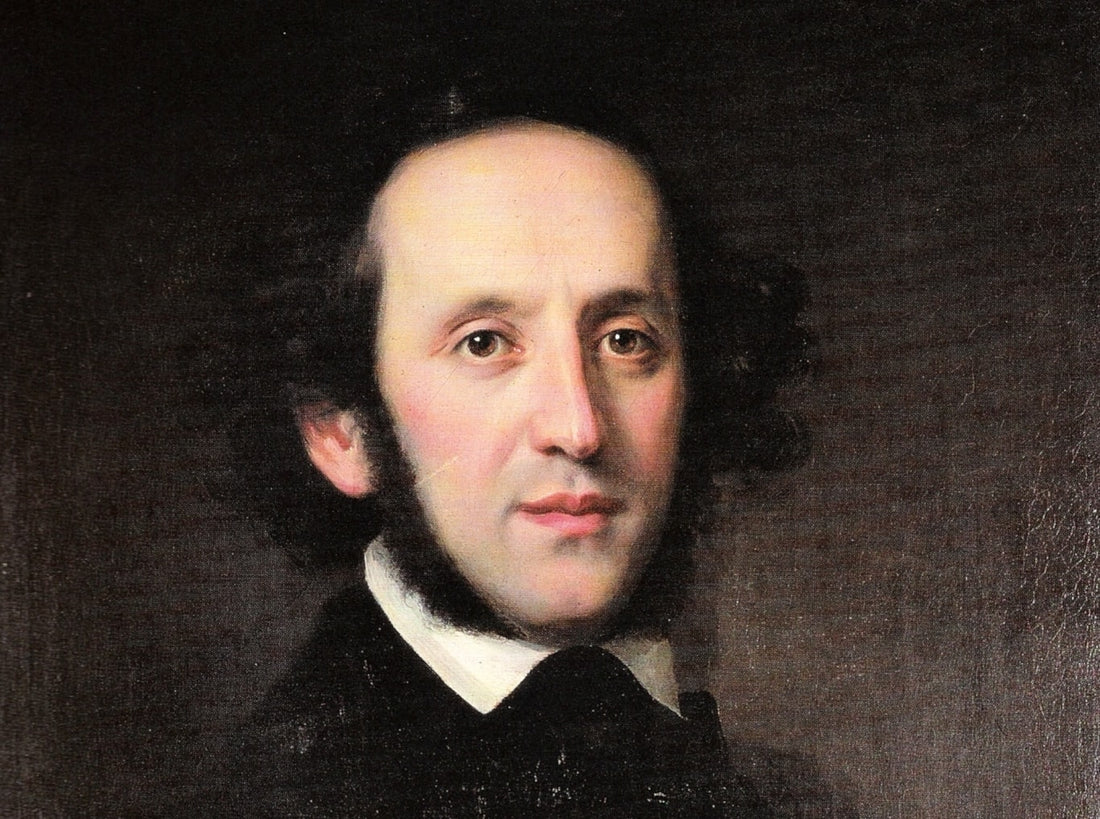Felix Mendelssohn (1809 – 1847) was one of the great pianists and piano-music composers of his day. His parents sent him to first-rate music teachers in Berlin and Paris who gave him a sense of history that always affected his work. Although he is a Romantic composer, his intellect gravitated toward the complexity of late Baroque music and the elegant drama of Mozart, making his own compositions a wonderful mixture of sweeping emotion and mathematical precision. Nowhere is this more evident than in his concertos – for piano, for violin, and for both together. Four recent recordings, focused on some of the lesser-known examples from the genre, prove the timelessness of these pieces once again.
Before Mendelssohn composed his famous piano concertos, he had already written a couple of duo concertos for two pianos. These pieces had a practical purpose. He used to tour and concertize with his sister, Fanny, who was reportedly an even better pianist than he was, as well as an excellent composer, which you can read about in a piece I wrote for Copper:
https://psaudio.com/article/fanny-mendelssohn/
Both of Felix’s duo concertos are included in the newest release by Roberto Prosseda, part of his project to record all of the Mendelssohn concertos for Decca. Prosseda is joined by pianist Alessandra Ammara (with whom he also made an album of Mendelssohn’s four-hand duets) and the Residentie Orkest The Hague, conducted by Jan Willem de Vriend.
The earlier of the two-piano works is in E major, with the standard three-movement format that all his concertos share. In the second movement, Adagio non troppo, de Vriend coaxes a rich, velvety sound from the Hague players, clearly leaning into the Romanticism. When Prosseda and Ammara enter, they carry on that silky texture, with plenty of rubato and passion.
Their interpretation of faster movements tends more toward Mendelssohn’s brainy side. This is especially true in their recording of the second of the two-piano concertos, in A flat major. The opening movement, marked Allegro vivace, starts with a symphonic-sized exposition, typical of early 19th-century sonata-concerto form, but dense with the 18th-century counterpoint Mendelssohn loved so much as a student.
In the solo exposition, the pianists emphasize the interplay of polyphonic lines, highlighting Mendelssohn’s technical skills. There are moments when their ensemble could have been more precise, but it’s a spirited and expressive performance.
Mendelssohn was in his early 20s when he wrote his Piano Concert No. 1 in G Minor, Op. 25, a work that enjoyed great popularity in Europe. Both Clara Wieck Schumann and Franz Liszt played it in concerts. There are many terrific recordings of this piece (a favorite of mine is the 1998 version by Andras Schiff with the Bavarian Radio Orchestra, conducted by Charles Dutoit, on Decca), and musicians continue to explore its depths. Bulgarian pianist Lachezar Stankov is among the most recent to attempt it, in a recording on Meridian with the Royal Philharmonic Orchestra led by Linus Lerner.
Marked Molto allegro con fuoco (“with fire”), the first movement requires both virtuosity and power. Stankov has plenty of both. Notice that, unlike the more conservative earlier concertos, this one does not start with a long orchestral exposition, but only a few bars of the orchestra before the piano comes roaring in.
On this album, Stankov is joined by his brother, violinist Ivo Stankov, for a performance of Mendelssohn’s Concerto for Violin, Piano and Orchestra in D minor. Lerner seems determined not to over-sentimentalize the Romantic elements of the work; the Royal Philharmonic gives a reserved but eloquent reading, particularly in the middle Adagio movement. While both Stankovs follow Lerner’s introspective mood, it works better for Lachezar than for Ivo: The violin sound is often harsh and unconvincing.
The Concerto for Violin and Piano gets a more successful rendering on a new Brilliant Classics album by violinist Solomiya Ivakhiv and pianist Antonio Pompa-Baldi. The Slovak National Symphony Orchestra, is conducted by Theodore Kuchar.
Kuchar does excellent work here. From the orchestra’s first phrases of the highly contrapuntal first movement, we’re immediately drawn in, as if we’ve landed in the middle of a sound world that already existed long before we arrived. Pompa-Baldi and Ivakhiv match that intensity, making their duet sections massive enough to counterbalance the whole orchestra.
And then there’s the Adagio, offering quite a contrast to the Stankov version. Kuchar lets the orchestra swell and recede, a much more Romantic approach. And the solo playing, particularly Ivakhiv’s violin, is plaintive and sweet, with the lifts and breaths in bowing that define Mendelssohn’s elegant style.
Also included on this record is Mendelssohn’s Concerto for Violin and Strings in D minor. This is not the far more famous and beloved Violin Concerto, which is in E minor and uses a full orchestra. The D minor concerto is not as spectacular and solid a work, but there’s a good reason for that: Mendelssohn wrote this concerto with strings in 1822, at the age of 13, so let’s cut him some slack!
Ivakhiv approaches the Allegro first movement with purpose and clarity in her phrasing. Kuchar’s orchestra might have supported her with more focus, but there are still some excellent moments in this performance.
Another violinist recorded this concerto in the past year. Henry Raudales not only plays the solo part but also conductions the Munich Radio Orchestra in a new release from BR-Klassik. Mendelssohn’s six String Symphonies round out the album.
The concerto’s galant second movement, marked Andante, proved just how steeped young Mendelssohn was in the works of Haydn and Mozart when he wrote it. Raudales prances delicately through the sprite-like solo writing, showing off the mind of a Wunderkind composer who would soon be recognized as a genius.
There’s no better way to end than with a Mendelssohn finale, in this case the Allegro third movement of the Concerto for Violin and Strings. Raudales’ interpretation simply sparkles with graceful wit, and the Munich Radio Orchestra matches his lithe, effortless articulation.
Header image courtesy of Wikimedia Commons.



